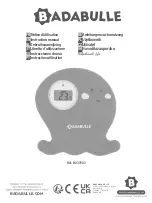
Connection diagrams
Lighting loads
L’
16 A AC1
Led load
20 x 20 W
S1
1500 W
1500 W
μ
16A AC1
230 V
~
0.8A max.
230 V
~
S2
—
—
—
—
290 W / C=32
μ
f
580 W
Incandescent, Halogen 230 V
2300 W
S1
1500 W
1500 W
μ
16A AC1
230 V
~
0.8A max.
230 V
~
S2
—
—
—
—
290 W / C=32
μ
f
580 W
Halogen VLV via ferromagnetic or electronic transformer
1500 W
S1
1500 W
1500 W
μ
16A AC1
230 V
~
0.8A max.
230 V
~
S2
—
—
—
—
290 W / C=32
μ
f
580 W
Fluocompact with electronic ballasts
23 x 23 W
S1
1500 W
1500 W
μ
16A AC1
230 V
~
0.8A max.
230 V
~
S2
—
—
—
—
290 W / C=32
μ
f
580 W
Parallel compensated fluorescent tubes
1000 W
S1
1500 W
1500 W
μ
16A AC1
230 V
~
0.8A max.
230 V
~
S2
—
—
—
—
290 W / C=32
μ
f
580 W
Fluorescent via electronic ballasts
1000 W
Connected to Klik LDS lighting distribution box
Connected directly to a single luminaire
LOOP (brown)
NEUTRAL (blue)
Sw B (black)
Sw A (black)
LOOP
NEUTRAL
SWITCH
RETURN
Circuit B
Circuit A
Copper Link (1)
Terminal
block
wall
switch
(grey)
Push button
Copper Link (2)
LOOP
N
SW(B
)
SW(A
)
AU
X
hager reference:
WMPS12R
With klik KLDS marshalling boxes (EEK513W)
N
L’
L
N
PB
L
230 V
Push-button for
presence/absence
detection
EEK513W
Hager reference:
WMPS12R
Push-button
EM
DA-
DA+
\
SL
L
N
Direct wiring to a luminaire (EEK510B)
Connection of EEK513W
/
EEK515W to KLMB Marshalling Box
Implementation requirements
Requirements for optimal detection
- Recommended installation distance from ground: 2.5 m
➡
3.5 m.
- In offices, the detector must be installed above the workstation.
- When associating several detectors, detection areas shall overlap.
-
Keep away from environmental disturbances (heat sources, partitions,
houseplants, ventilation...).
da- white
da+ orange
black
Normally open
retractive switch
Polarity free
digital output
blue
brown
Live
230 V 50Hz
supply
Neutral
L
Connection to ballast only
Do not connect to other occupancy sensors
30
90
16A
LOCK
ED
16A
LOCKE
D
16A
LOCK
ED
16A
LOCKE
D
16A
LOCKED
PRESS
PRESS
R
E
L
E
A
S
E
REL
EAS
E
RELE
ASE
16A
LOCKE
D
With klik.system KLMB marshalling boxes (EEK51.P)
Troubleshooting
• False switching of lighting point: check that the detector is not exposed
directly to a heat source or a lighting source or is not placed above a
ventilation grid...
• The range of the detector is too short: check whether the distance of the
device from the ground is sufficient and its location is optimal.
4
Hager Controls S.A.S., 33 rue Saint-Nicolas, B.P. 10140, 67703 SAVERNE CEDEX, France - www.hager.com
05.2017 6LE000505C






















